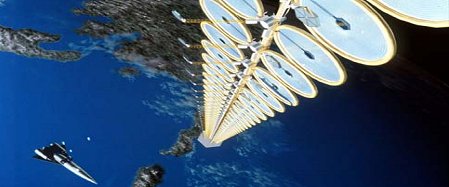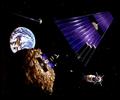 Space Studies Institute
(SSI)
Space Studies Institute
(SSI)
Larger and
SPS with spaceplane images
A solar power satellite beams down energy
to a reception area on Earth in the form
of microwaves, which would be safe for
both birds as well planes to fly through.
Global energy demand continues to grow along with worldwide concerns over fossil fuel pollution, the safety of nuclear power and waste, and the impact of carbon-burning fuels on global warming. As a result, space-based, solar power generation may become an important source of energy in the 21st Century. According to a study by the Space Studies Institute (SSI), the nonprofit foundation founded by the late physicist and visionary Gerard O'Neill (19??-92), over 99 percent of the materials needed for building solar power satellites (SPS) can be obtained from Lunar materials. This would reduce the cost of SPS construction by almost 97 percent compared to the alternative of use materials launched from Earth.

NASA (A relatively small suntower can
be used to exploit Solar power.)
Promoted as early as 1968 by Peter Glaser, then a NASA scientist, Solar power satellites can be built to convert direct Solar radiation received in the full, unobstructed intensity possible in space to direct current (DC), electrical power. Although early photovoltaic systems were very inefficient, state-of-the-art systems can now convert the sun's energy into electricity at a rate of 42 to 56 percent, according to Neville Marzwell, a NASA scientist at the Jet Propulsion Laboratory in California. If not built in space, giant sheets of photovoltaic cells could be unfolded in low Earth orbit by astronauts or robots, and then boosted to about 22,300 miles above the equator where they would remain in the same spot over the Earth. Free of atmosphere or dust or clouds, such photovoltaic arrays would collect at least eight times more solar energy than they could on the ground and would work 24 hours a day, practically all year.

NASA -- larger and
jumbo images
Space
settlements will be needed
to fully exploit Solar energy and
asteroidal and cometary resources.
Solar-generated, DC power would be converted to microwaves and transmitted through space as electronically steerable microwave beams. Called "wireless power transmission" (WPT)), these beams would be captured by receivers (covering several square miles) in remote areas on Earth and converted back into DC power for terrestrial electrical grids. According to the SunSat Energy Council, a non profit organization affiliated with the United Nations, the beam would be so low in density that it wouldn't even feel warm if you happened to walk through it.
In 1990s, Japan research flew a small airplane powered by microwaves beamed up from the ground. Indeed, because the island nation has no energy resoures of its own, Japanese officials have announced plans to have their first solar power satellite in operation by the year 2040. WPT, however, also has great potential for non-terrestrial applications, including electrically propelled spaceships for interplanetary (within Solar System) as well as interstellar transport (at sublight speeds) by providing beamed power for space propulsion systems, such as those using space Sails.
 NASA -- larger
and
jumbo
images
NASA -- larger
and
jumbo
images
Exploration
ships to Jupiter and its
moons (e.g., Io) and beyond could
someday be propelled by lasers
generated by Solar power satellites
located among the inner planets.
Although past spacecraft development has focused on propellants which are expelled by the energy generated on board the vessel, some proposed spacecraft designs would use energy that is not carried on board. This energy would be transmitted to the spacecraft in the form of a radio frequency or laser beam, thus greatly reducing the mass of the spacecraft. (For now, further details can be found in Paul Woodmansee's discussion of Light Sails and at a NASA web link page on Solar Sails. Another illustration of an interplanetary application can be found at the Center for Space Power, a NASA "Commercial Space Center" hosted by Texas A&M University.)

Robert Forward, NASA --
larger B&W image
A space sail with detached inner
sail in deceleration mode.